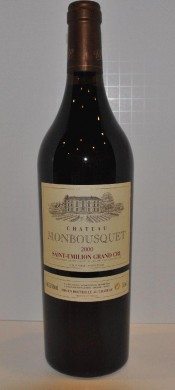 When you turn Bordeaux seller like me, a once covetous disposition for hoarding claret evaporates like morning dew in an afternoon sun. Selling first growths for ten times original investments at $1,000+ per bottle can be disorienting. A plethora of exciting alternatives to rock your palate and backfill the cellar are sympathetic enough to this profitable culling and can turn Bordeaux enthusiasm into a retired phase. That is, of course, until you drink a wine like the (****1/2 $85) 2000 Château Monbousquet and every objection to holding, buying, or drinking Bordeaux plummets through the trap doors of wine nirvana to conjure up familiar yearnings for en primeur dabbling.
When you turn Bordeaux seller like me, a once covetous disposition for hoarding claret evaporates like morning dew in an afternoon sun. Selling first growths for ten times original investments at $1,000+ per bottle can be disorienting. A plethora of exciting alternatives to rock your palate and backfill the cellar are sympathetic enough to this profitable culling and can turn Bordeaux enthusiasm into a retired phase. That is, of course, until you drink a wine like the (****1/2 $85) 2000 Château Monbousquet and every objection to holding, buying, or drinking Bordeaux plummets through the trap doors of wine nirvana to conjure up familiar yearnings for en primeur dabbling.
I have busied myself sourcing the riveting likes of Occhipinti, Clos Rougeard, and Huet in the wake of unloading a first wave of Lafite, Margaux, Mouton Rothschild and more. Bottles become cases and the regal Bordeaux tradition is trumped. Exotic, fresh, lively, ethereal, and intellectually stimulating wines from Loire Valley, Sicily, Alsace, and beyond are now sitting in rack spaces warmed for twenty or more years by cellar predecessors from the Médoc. I have contemplated this culling process for some time now; half spurred on by disdain for the speculative run up in Bordeaux prices and the other half succumbing to a changing palate preference for fresh pretty wines with overlays of funkiness and velvet textures.
My friend Rich was heading to Bordeaux with a few other wine writers so we arranged a bon voyage dinner at one of our secret Boston BYOB spots on the evening preceding his departure. The night called for Bordeaux so I pulled the 2000 Château Monbousquet from the cellar. My first experience with Monbousquet was the ’98 vintage when it grabbed my attention with its rich fruit and classic claret character for less than $50. It was a long ignored Right Bank château in Saint-Émilion producing mediocre wine for a very long time until turning around following the 1993 acquisition and subsequent renovation by Parisian supermarket operator Gérard Perse who also went on to acquire Château Pavie, Château Pavie-Decesse and Château La Clusière (I guess the supermarket business is pretty lucrative in Paris).
 The vineyards are primarily planted to merlot, with substantial cabernet franc and some remaining hectares of cabernet sauvignon. Monsbousquet earned Grand cru status in the Classification of Saint-Émilion, but having tasted the ’98, ’00, and ’03 I formed the sense they would compete handsomely if tasted blind next to some of the Premier grands crus.
The vineyards are primarily planted to merlot, with substantial cabernet franc and some remaining hectares of cabernet sauvignon. Monsbousquet earned Grand cru status in the Classification of Saint-Émilion, but having tasted the ’98, ’00, and ’03 I formed the sense they would compete handsomely if tasted blind next to some of the Premier grands crus.
I opened 2000 Monbousquet on two other occasions. It strutted its stuff handsomely immediately after release but was closed and less accessible four years ago. This time, at age eleven, it boasted all its beauty and mystery and unabashedly expressed the strength, complexity, age-ability, and grace that convinced me twenty five years ago that the finest wines in the world hail from Bordeaux. Leaning towards a modern style, this bottle showed a gorgeous, sexy, black cherry fruit center overlaid with tantalizing camphor and smoke. Each component stands tall, but lays on top of one another in such an interconnected and harmonious fashion that it makes you want to swoon. The texture is deceivingly silky and light in the face of such pronounced smokiness and solid rich fruit. With the chance to taste the wine three times over its short lifetime, its been educational tracking how well the tannins have progressively resolved since release. The wine is drinking perfectly now, but has decades of lifetime ahead of it.
I need to stop maligning Bordeaux. This wine is not akin to Lafite; neither in subtlety nor price tag. Buying Monbousquet on release for $50 is a steal, and proves there is still life in Bordeaux for sensible wine enthusiasts who cut their teeth on these wines when they were all more sensibly priced thirty years ago. It’s easy to get distracted when you discover winemakers like Foucalt, Huet, and Occhipinti. But reselling one bottle of Lafite in the secondary markets can just as easily yield you a case and a half of Monbousquet. Now that’s a strategy.